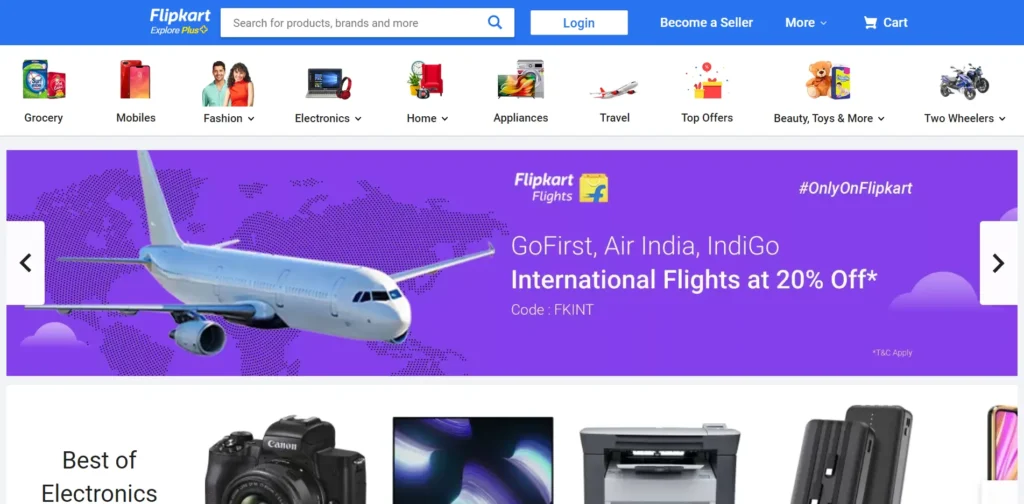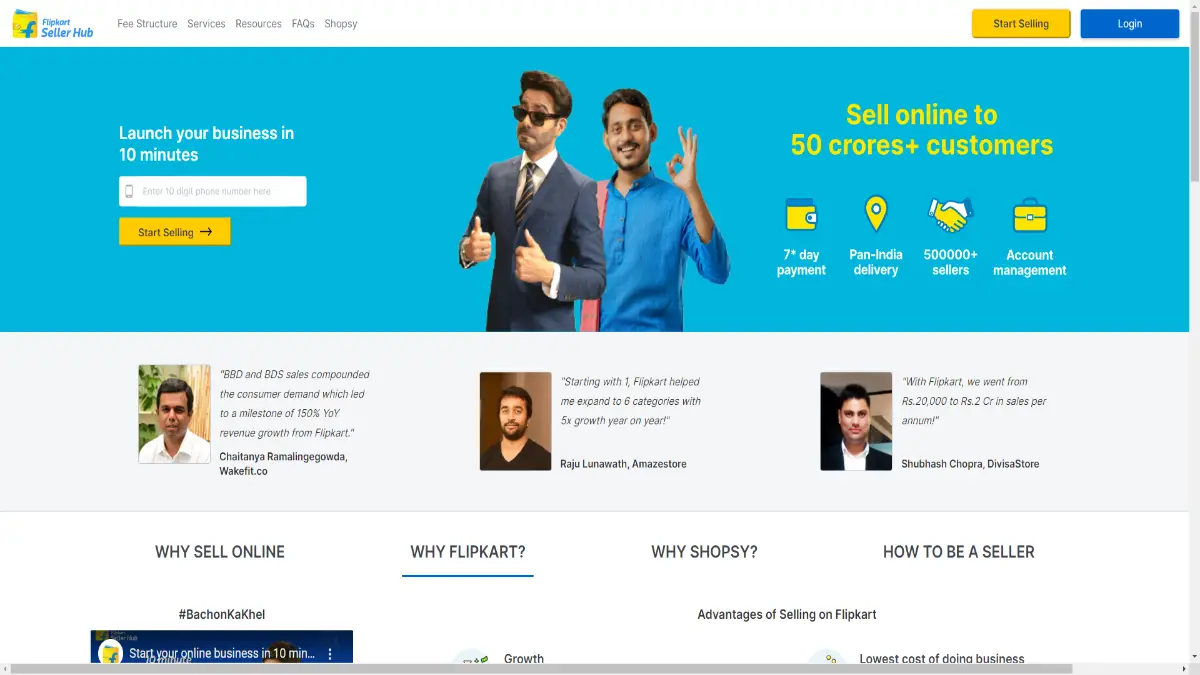Flipkart, a pioneer in India’s e-commerce industry, was established in 2007 by Sachin Bansal and Binny Bansal. Initially focusing on book sales, the platform has since diversified its offerings to include a wide array of products like electronics, fashion, beauty, and groceries. Presently, owned by Walmart, Flipkart caters to over 50 crore registered users.
Playing a monumental role in transforming India’s e-commerce landscape, Flipkart has democratized online shopping, especially in smaller towns and cities. It has empowered small and medium-sized businesses to connect with a larger audience. The platform’s user-friendly interface and efficient delivery system have solidified its position as a favored choice among consumers, contributing to its industry success.
For businesses, selling on Flipkart is imperative as it provides access to a vast and expanding customer base. By listing products on Flipkart, businesses can reach consumers nationwide, enhancing their sales potential.
Moreover, Flipkart offers sellers tools and resources to enhance listings, manage inventory efficiently, and promote products effectively. This aids businesses in boosting visibility and sales performance on the platform. Overall, selling on Flipkart presents a valuable opportunity for businesses looking to broaden their presence in India’s thriving e-commerce sector.
Section 1: Understanding the Flipkart Marketplace

Flipkart stands as a premier online marketplace in India, enabling third-party sellers to showcase and sell products to millions of customers nationwide. The marketplace model ensures a level playing field for all sellers, irrespective of their size or location. Flipkart equips sellers with a range of tools and resources to bolster their success on the platform, including a robust seller dashboard, advertising tools, and customer support.
Types of Sellers on Flipkart
There are three types of sellers on Flipkart: individual, partnership, and company.
- Individual sellers are sole proprietors who sell under their own name.
- Partnership sellers are two or more individuals who sell under a partnership agreement.
- Company sellers are legal entities that sell under their registered name.
Each seller type has specific requirements and documentation necessary for registration on Flipkart.
Documents Required to Sell on Flipkart
If you intend to become a seller on Flipkart, ensure you have the following documents ready:
- GSTIN (Goods and Services Tax Identification Number)
- PAN Card (Personal PAN for business type “Proprietorship” and Personal + Business PAN for business type “Company”)
- GSTIN/TIN Number (Note: may not be mandatory for certain categories)
- Bank account and supporting KYC documents (such as Address Proof and Canceled Cheque)
Having these documents prepared facilitates a successful registration process on Flipkart as a seller.
How to Sell On Flipkart (Become a Flipkart Seller)

Registering as a seller on Flipkart is a simple process with a few easy steps. Here’s a step-by-step guide to becoming a Flipkart seller.
Step 2: Create a New Seller Account
On the registration page, click on the “Register” button to create a new seller account. Enter basic details like name, email, and mobile number.
Step 3: Provide Business Information
Enter business information like name, address, business entity type, tax registration number (GSTIN), and bank account details for payments.
Step 4: Upload Required Documents
Upload essential documents like PAN card, GST registration certificate, and canceled cheque for bank account verification to complete registration.
Step 5: Complete the Verification
Flipkart reviews your application and verifies details. It may take a few days, and additional information may be requested.
Step 6: Start Selling
Once approved, list and sell your products on Flipkart. Utilize the seller dashboard to manage your account and track sales performance.
Charges to Sell on Flipkart
Upon making a sale, the following deductions apply to the order item value:
- Commission fee: Percentage of the order item value based on the product’s category.
- Shipping fee: Calculated by product weight, shipping location, and method.
- Collection fee: Varied based on order item value and customer payment method.
- Fixed fee: Slab-wise and variable based on order item value.
- GST: Applicable to all components.
Consider these factors when pricing products to ensure covering commission, shipping, collection, fixed fees, and GST and to guarantee profitability.
Section 2: Optimizing Your Flipkart Seller Account
After registering as a seller on Flipkart, optimizing the seller account is crucial to enhance visibility and sales.
Best Practices for Setting Up and Managing Your Flipkart Seller Account
- Complete your seller profile: Ensure accuracy and completeness for trust-building and customer engagement.
- Manage inventory: Maintain updated inventory to prevent cancellations and delays.
- Create high-quality product listings: Use appealing images and detailed descriptions for a professional storefront.
- Price products competitively: Research and offer competitive pricing to attract customers.
- Optimize product listings for search: Use relevant keywords for improved discoverability.
- Utilize Flipkart’s seller tools: Streamline operations with platform tools for better sales performance.
- Provide excellent customer service: Respond promptly and professionally to build customer trust.
By following these best practices, sellers can optimize their Flipkart account and boost visibility and sales on the platform.
Section 3: Managing Orders and Fulfillment
Efficiently managing orders and ensuring timely fulfillment are vital once orders commence on Flipkart. Here’s a guide on managing and fulfilling orders effectively:
- Understanding Flipkart’s order management system: Centralized dashboard for order tracking and management.
- Accepting and processing orders: Timely acceptance and processing to initiate shipping.
- Shipping and delivery: Utilize Flipkart’s shipping options for quick order fulfillment.
- Handling returns and refunds: Responsibility for timely and professional handling of returns and refunds.
Best practices for handling returns and refunds on Flipkart
- Have a clear returns policy: Transparent policy for customer understanding.
- Respond promptly to return requests: Timely response to avoid delays.
- Inspect returned products: Careful inspection to avoid processing refunds for damaged items.
- Issue refunds promptly: Quick refund processing for customer satisfaction.
Conclusion
Selling on Flipkart presents significant opportunities for businesses seeking expansion and entry into India’s growing e-commerce market. Our guide covers essential aspects of selling on Flipkart, including registering as a seller, account optimization, order & fulfillment management, product marketing, and strategies for sales growth.
Key takeaways include:
- Flipkart functions as a marketplace open to individuals, partnerships, and companies.
- Optimizing seller accounts and creating compelling listings boosts visibility and sales.
- Efficient order management, returns handling, and customer service enhance goodwill and repeat business.
- Marketing through Flipkart tools and other channels aids in driving traffic and sales.
- Expanding product catalog and analyzing sales data contribute to overall sales growth.
As India’s e-commerce sector flourishes, selling on Flipkart can be pivotal for business growth. By adhering to the best practices outlined here and staying informed of Flipkart policies, businesses can establish a successful presence on this renowned e-commerce platform.
Also Read: How to start a business without money
People Also Ask: Sell On Flipkart
How much does it cost to sell on Flipkart?
Flipkart charges commission fees based on product category and selling price, along with additional costs like shipping fees. Refer to the Flipkart seller portal for the fee structure.
How to sell on Flipkart without GST?
GST registration is mandatory for selling on Flipkart, except for book sales. For solely selling books, a PAN card suffices.
How to sell on Flipkart without a brand?
Register as an individual seller on Flipkart if you lack a brand. Create an account on the Flipkart Seller Hub, provide necessary details, and upload product listings.
What are the hot products to sell on Flipkart?
Popular product categories on Flipkart include electronics, fashion, home and kitchen, beauty, and groceries.
How to increase sell on Flipkart?
Boost sales on Flipkart with optimized product listings, competitive pricing, excellent customer service, promotions, advertising, and marketing initiatives via Flipkart’s tools.
Refer to Flipkart FAQ for more insights. You May Also Like:

